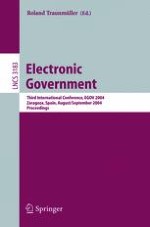2004 | Book
Electronic Government
Third International Conference, EGOV 2004, Zaragoza, Spain, August 30-September 3, 2004. Proceedings
Editor: Roland Traunmüller
Publisher: Springer Berlin Heidelberg
Book Series : Lecture Notes in Computer Science
Included in: Professional Book Archive
